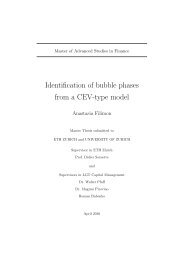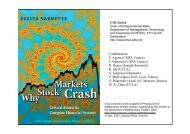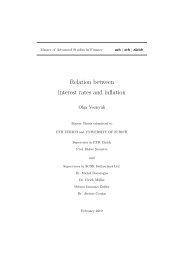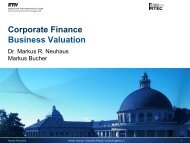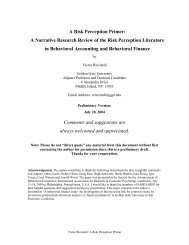Tail Dependence - ETH - Entrepreneurial Risks - ETH Zürich
Tail Dependence - ETH - Entrepreneurial Risks - ETH Zürich
Tail Dependence - ETH - Entrepreneurial Risks - ETH Zürich
Create successful ePaper yourself
Turn your PDF publications into a flip-book with our unique Google optimized e-Paper software.
3.51 ˆ λ + (k) for the lower tail of the nine assets and the index S&P 500 is<br />
plotted in black for ˆ β(k) calculated by least squares method applied to<br />
linear additive single factor model: X = β·Y +ε and adapted to the first<br />
condition: Y ≥ Y (k) ∩ X ≥ X(k), ˆν(k = 4%) and ˆ l(k) in dependence<br />
of threshold k for k/N = 3% . . .10%, in blue for ˆ β(k) and ˆ l(k) adapted<br />
to the first SI condition for comparison, in green for Reference ˆ β and<br />
ˆl(k), and for Reference ˆ λ + (k = 4%) is given in red. Y denotes the index<br />
return vector of S&P 500 and X denotes asset return vector of the nine<br />
assets for a time interval ranging from January 1991 to December 2000. 91<br />
3.52 ˆ λ + (k) for the upper tail of the nine assets and the index S&P 500 is<br />
plotted in black for ˆ β(k) calculated by least squares method applied to<br />
linear additive single factor model: X = β · Y + ε and adapted to the<br />
second condition: Y ≥ Y (k), ˆν(k = 4%) and ˆ l(k) in dependence of<br />
threshold k for k/N = 3% . . .10%, in blue for ˆ β(k) and ˆ l(k) adapted<br />
to the first SI condition for comparison, in green for Reference ˆ β and<br />
ˆl(k), and for Reference ˆ λ + (k = 4%) is given in red. Y denotes the index<br />
return vector of S&P 500 and X denotes asset return vector of the nine<br />
assets for a time interval ranging from January 1991 to December 2000. 92<br />
3.53 ˆ λ + (k) for the lower tail of the nine assets and the index S&P 500 is<br />
plotted in black for ˆ β(k) calculated by least squares method applied to<br />
linear additive single factor model: X = β · Y + ε and adapted to the<br />
second condition: Y ≥ Y (k), ˆν(k = 4%) and ˆ l(k) in dependence of<br />
threshold k for k/N = 3% . . .10%, in blue for ˆ β(k) and ˆ l(k) adapted<br />
to the first SI condition for comparison, in green for Reference ˆ β and<br />
ˆl(k), and for Reference ˆ λ + (k = 4%) is given in red. Y denotes the index<br />
return vector of S&P 500 and X denotes asset return vector of the nine<br />
assets for a time interval ranging from January 1991 to December 2000. 93<br />
3.54 ˆ βSI(N) plotted in black for the upper tails and plotted in green for the<br />
lower tails for 9 assets given by X and index S&P 500 given by Y using<br />
the linear single factor model: X = β · Y + ε and the first SI condition:<br />
Y ≥ Y (k) ∩ X ≥ X(k) for rolling time horizon windows of S = 2500<br />
considered data points from N = (1 . . .S), (2 . . .S + 1), . . ., (5736 − S +<br />
1 . . .5736) or a total time interval from July 1985 to Mars 2008. . . . . 100<br />
3.55 ˆ βSI(N) plotted in black for the upper tails and plotted in green for the<br />
lower tails for 9 assets given by X and index S&P 500 given by Y using<br />
the linear single factor model: X = β·Y +ε and the second SI condition:<br />
Y ≥ Y (k) for rolling time horizon windows of S = 2500 considered data<br />
points from N = (1 . . .S), (2 . . .S + 1), . . ., (5736 − S + 1 . . .5736) or a<br />
total time interval from July 1985 to Mars 2008. . . . . . . . . . . . . . 101<br />
3.56 λ + (N) for upper tails of index S&P 500 and the nine assets plotted<br />
in blue and λ − (N) for lower tails plotted in red using non-parametric<br />
approach given by equation ˆ λ +,− = 1/ max<br />
�<br />
1,<br />
l<br />
ˆβ +,−<br />
SI<br />
� ˆν<br />
with coefficients<br />
ˆν, l, and ˆ β +,−<br />
SI for rolling time horizon windows of S = 2500 considered<br />
data points from N = (1 . . .S), (2 . . .S+1), . . ., (5736−S+1 . . .5736) or<br />
a total time interval from July 1985 to Mars 2008. ˆ β +,−<br />
SI were calculated<br />
using the linear single factor model: X = β · Y + ε and the first SI<br />
condition: Y ≥ Y (k) ∩ X ≥ X(k). . . . . . . . . . . . . . . . . . . . . . 102



